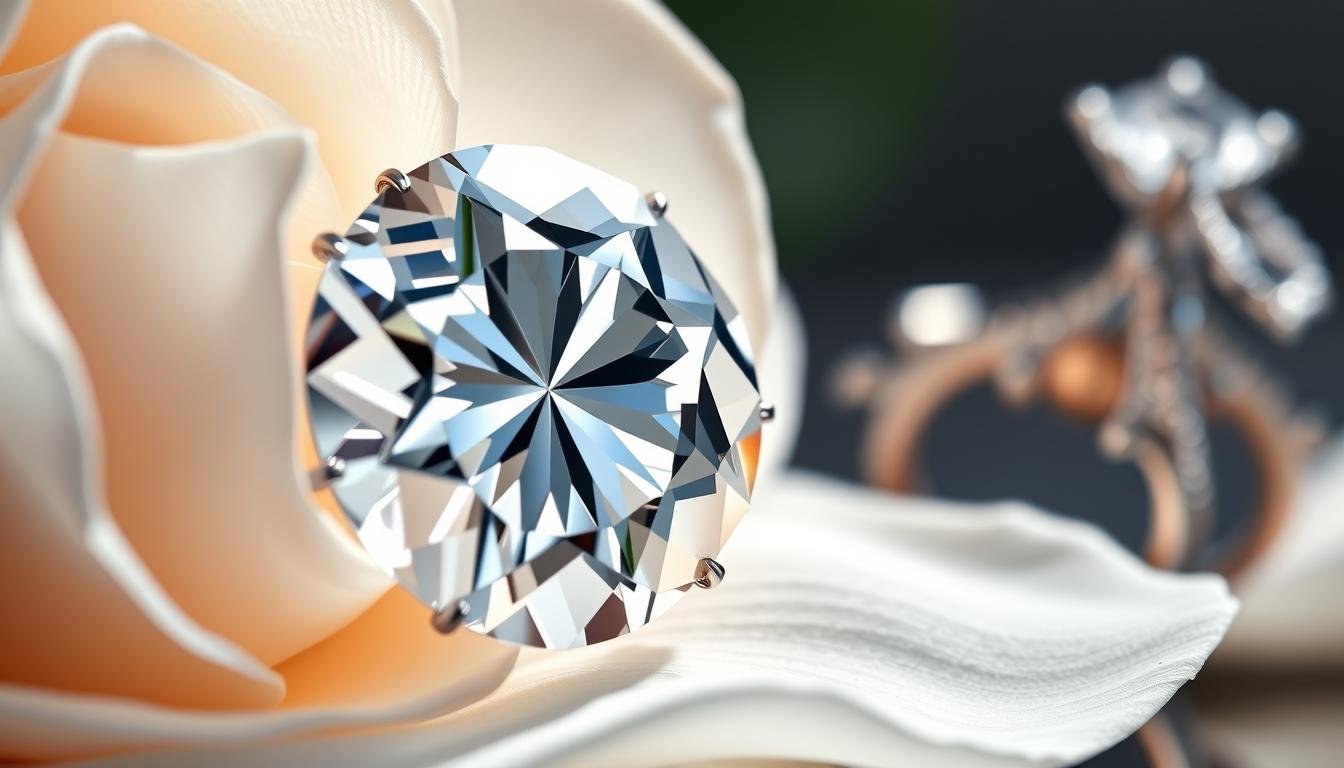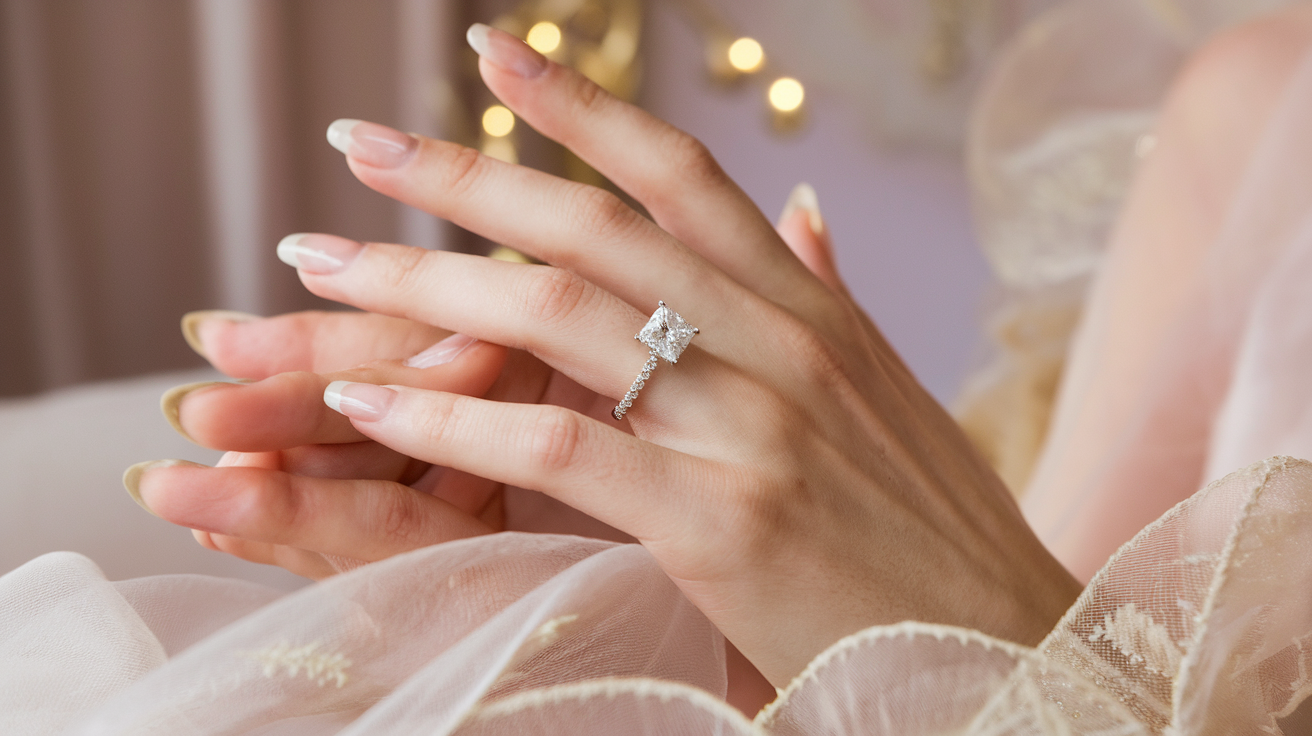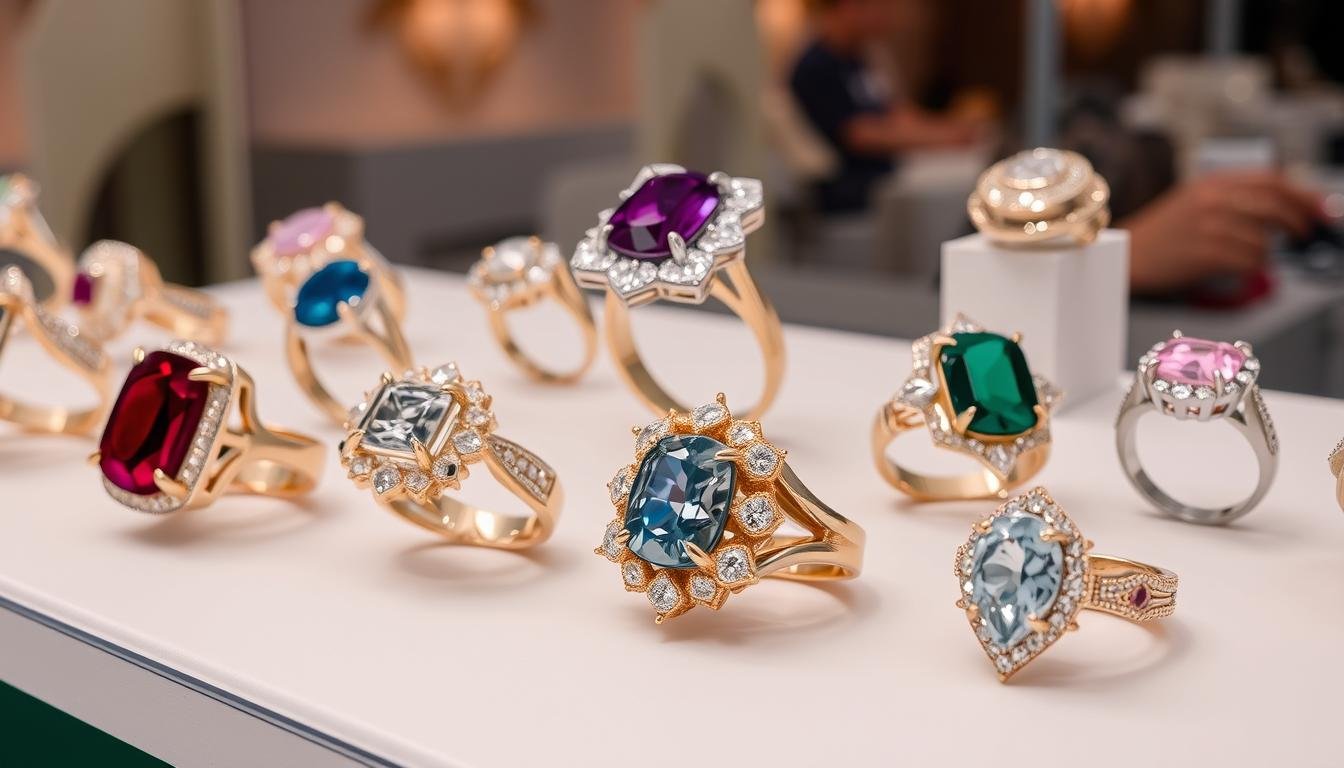Finding the perfect engagement ring is both exciting and overwhelming. There are so many diamond options, cut styles, and settings to choose from. But don’t worry, this guide will help you make a smart choice.
It covers everything from diamond formation to the latest trends in engagement rings. This article will guide you in finding a ring that shows your love and commitment perfectly.
Key Takeaways
- Learn about diamond basics, including natural vs. lab-grown diamonds and key terms.
- Discover the four Cs (cut, color, clarity, and carat) to find a high-quality diamond.
- Find out about popular diamond cuts and how they fit with different settings and lifestyles.
- Learn how to set a budget and get the best value for your money.
- Understand why diamond certification and grading reports are important for authenticity and quality.
the complete guide to diamondsand engagement, from decoding the diamond cuts to understanding diamond clarity, this article will be your trusted companion in your journey to finding the perfect engagement ring.
Understanding Diamond Basics: Your First Steps Into The World of Diamonds
Diamonds have fascinated people for centuries. Their beauty and allure are unmatched. To truly appreciate them, it’s key to know how they’re made and the difference between natural and lab-grown diamonds. Let’s explore the basics every buyer should know.
The Science Behind Diamond Formation
Diamonds form deep in the Earth’s mantle, under extreme heat and pressure. Over billions of years, carbon atoms turn into the hardest natural material. This process shapes each diamond’s unique traits, like diamond color and diamond carat weight.
Natural vs. Lab-Grown Diamonds
Natural diamonds come from the Earth, while lab-grown diamonds are made by humans. These man-made diamonds have the same properties as natural ones but are made in a more controlled way. Knowing the difference between natural and lab-grown diamonds is crucial for making a smart choice.
Key Terms Every Diamond Buyer Should Know
- Carat: The unit of measurement for the weight of a diamond, with one carat equaling 0.2 grams.
- Diamond Certification: A report from an independent gemological laboratory that provides a detailed analysis of a diamond’s quality and characteristics.
- Clarity: The measure of a diamond’s internal and external flawlessness, ranging from Flawless to Included.
- Cut: The proportions and symmetry of a diamond’s facets, which greatly impact its brilliance and fire.
- Diamond Color: The degree of a diamond’s whiteness or lack of color, graded on a scale from D (colorless) to Z (light yellow).
Knowing these basic concepts will help you make a confident choice when picking the perfect diamond.
“Diamonds are forever, and so is the knowledge that comes with understanding them.”
The Four Cs: Breaking Down Diamond Quality
Choosing the right diamond for your engagement ring involves the Four Cs: cut, color, clarity, and carat weight. Knowing these factors helps you pick a diamond that fits your style and budget.
Diamond Cut Grades Explained
The cut of a diamond is very important. It affects the stone’s sparkle, fire, and scintillation. Diamonds are rated from Poor to Excellent. A well-cut diamond greatly enhances the gem’s look and value. Choosing a well-cut diamond can make a big difference.
Color Rating System Decoded
Diamond color ranges from D (colorless) to Z (light yellow or brown). Diamonds closer to D are rarer and more valuable. While colorless diamonds are most sought after, near-colorless diamonds also offer great value and beauty.
Clarity Scale and Its Impact
Clarity shows the presence of internal and external flaws. Diamonds are graded from Flawless to Included. Flawless diamonds are rare and expensive. Yet, eye-clean diamonds with minor inclusions that aren’t visible to the naked eye can be a great value.
Carat Weight and Pricing
Carat weight measures a diamond’s size. As size increases, so does price. While bigger diamonds are often more desirable, the balance between carat weight, cut, color, and clarity is key to the diamond’s value and beauty.
| Diamond Characteristic | Scale/Grading | Impact on Value |
|---|---|---|
| Cut | Poor to Excellent | The most critical factor, affecting brilliance, fire, and scintillation. |
| Color | D (colorless) to Z (light yellow/brown) | Rarer, higher-quality colors command higher prices. |
| Clarity | Flawless to Included | Fewer inclusions and blemishes increase a diamond’s value. |
| Carat Weight | Measured in carats (1 carat = 0.2 grams) | Larger diamonds are more valuable, but balance with other Cs is crucial. |
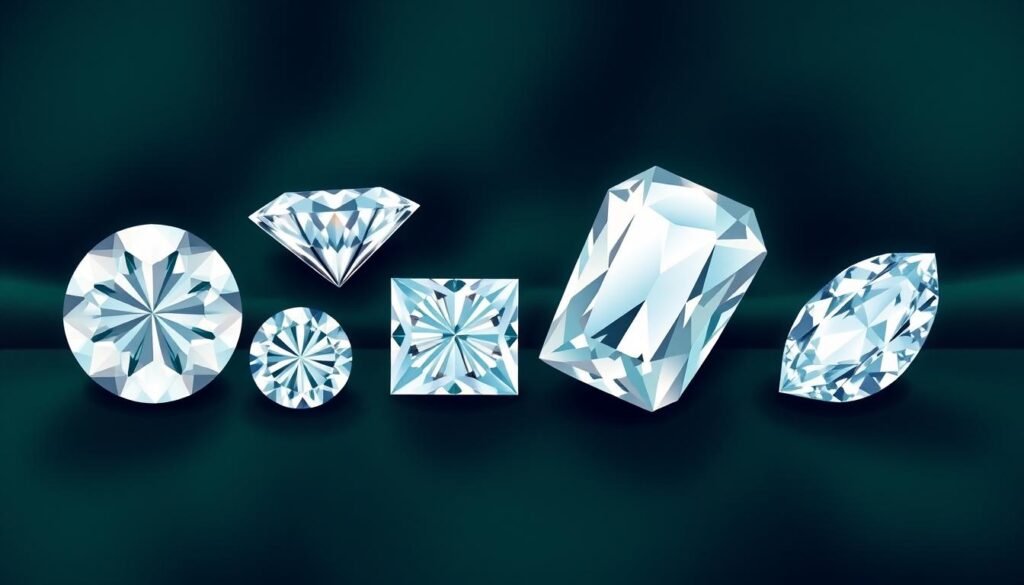
“Understanding the Four Cs is the key to finding the perfect diamond that aligns with your personal preferences and budget.”
Popular Diamond Cuts and Their Unique Characteristics
When it comes to diamond cuts, the choices are dazzling. From the classic round brilliant to the modern princess cut, each shape has its own charm. Knowing the differences can help you pick the perfect ring that tells your love story.
Round Brilliant: The Timeless Classic
The round brilliant is the top choice for engagement rings. Its 58 facets create stunning fire and brilliance. It’s perfect for those who want a classic, sophisticated look.
Princess Cut: Modern Elegance
The princess cut offers a modern flair. It’s a square or rectangular shape with sharp lines. It’s ideal for those who love a bold, modern ring.
Cushion Cut: Vintage Charm
The cushion cut combines old and new charm. It’s a soft, square shape with rounded edges. It’s great for those who want a vintage-inspired ring.
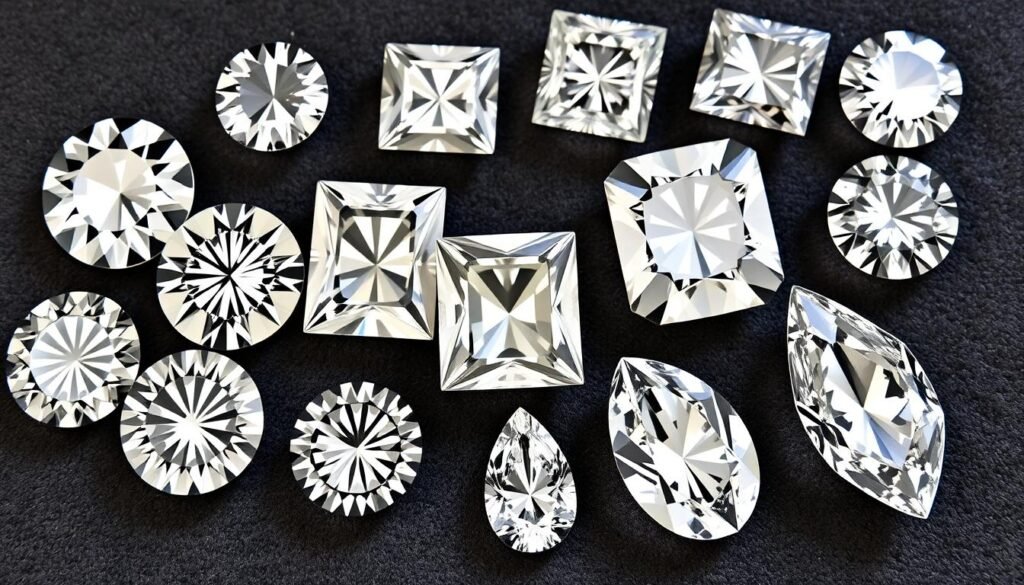
Whether you love the classic round, the modern princess, or the vintage cushion, there’s a diamond for you. Explore the options to find the one that speaks to your heart.
Engagement Ring Settings and Metal Choices
Choosing the right engagement ring involves picking the setting and metal. These choices greatly affect the ring’s look and feel. There are many options, from classic to modern.
Classic vs. Modern Settings
Traditional solitaire settings are still loved, with a single diamond as the star. But, newer settings like halo and three-stone rings are also popular. Halo settings add a ring of small stones around the diamond. Three-stone rings represent the past, present, and future of a couple’s love.
Choosing the Right Metal
The metal of the engagement ring also matters a lot. Platinum is strong and doesn’t cause allergies, with a bright white look. Gold comes in yellow, rose, and white, each with its own charm.
Setting Styles for Different Lifestyles
Think about the person’s lifestyle when picking a setting. For active people, a low-profile or bezel-set diamond is best. It won’t catch on clothes. For those who love glamour, a classic solitaire or halo setting might be perfect.
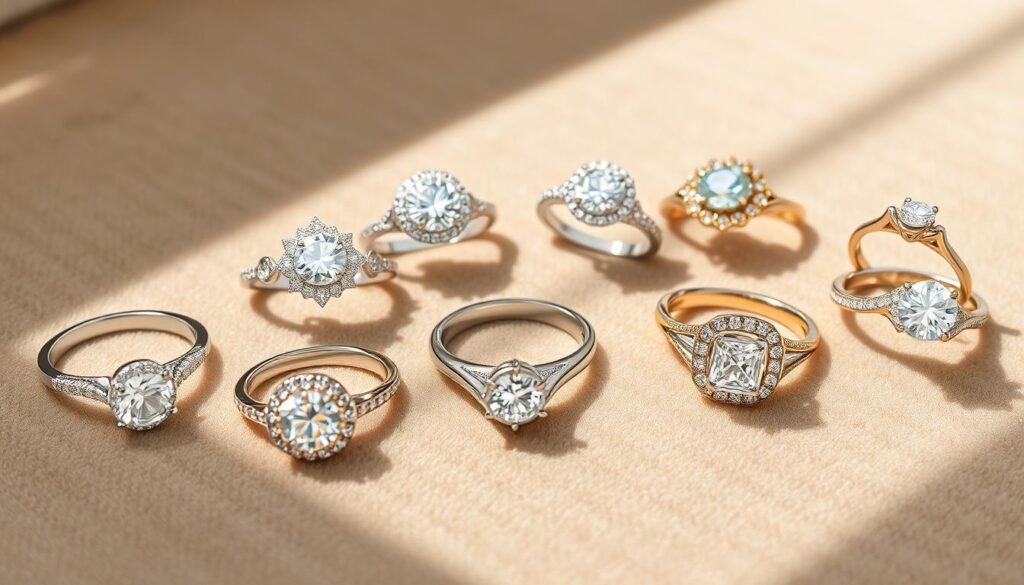
Choosing an engagement ring setting and metal is very personal. It should match the person’s style and personality. By exploring the many options, couples can find a ring that shows their love and commitment beautifully.
How to Determine Your Budget and Get the Best Value
When buying a diamond engagement ring, setting a budget is key. The diamond carat weight and certification greatly affect the price. Knowing how these factors impact cost helps you choose wisely and stay within your budget.
The size of the diamond, or carat weight, directly influences the price. But, it’s important to balance size with quality to get value. Look for a diamond that offers a good mix of size and quality within your budget.
Also, the diamond’s certification is crucial. A reputable certification, like from the Gemological Institute of America (GIA) or the American Gem Society (AGS), ensures the diamond’s quality and authenticity. While certified diamonds may cost more, the assurance and confidence they bring are worth it.
| Diamond Carat Weight | Average Price Range |
|---|---|
| 1 carat | $2,500 – $18,000 |
| 2 carats | $8,000 – $60,000 |
| 3 carats | $18,000 – $120,000 |
By considering the diamond carat weight and diamond certification, you can set a realistic budget. This way, you can find an engagement ring that balances quality and value. Remember, the goal is to choose a ring that shows your love and commitment, not just its price.
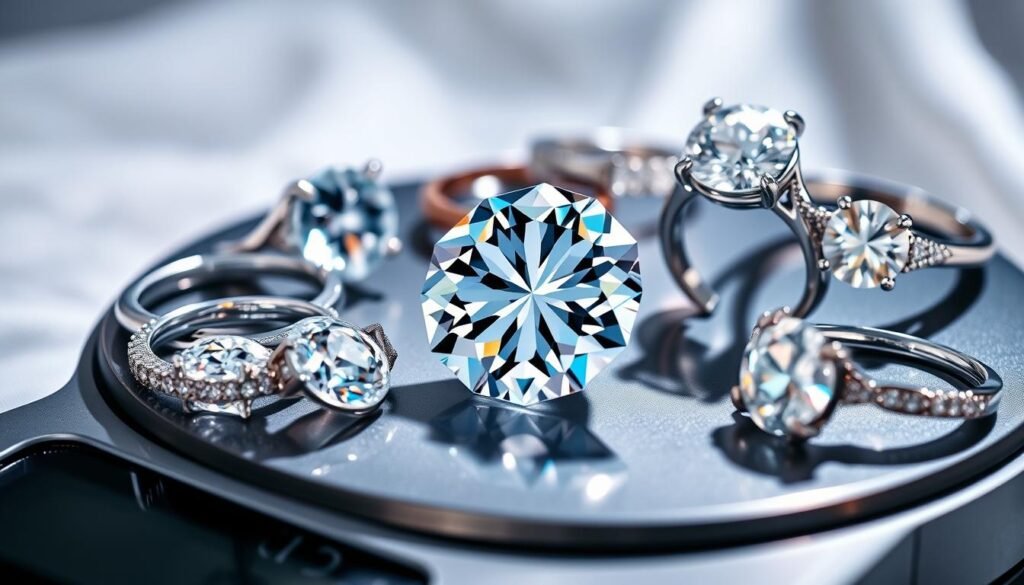
“The true value of a diamond lies not in its size, but in its ability to capture the essence of your love and commitment.”
Diamond Certification and Grading Reports
When you buy a diamond, knowing about diamond certification is key. These reports from trusted bodies give a full review of a diamond’s quality. They help you choose wisely.
Major Certification Bodies
The Gemological Institute of America (GIA) and the American Gem Society (AGS) are top names. They have experts who check diamonds carefully. They use the “Four Cs” to grade diamonds: cut, color, clarity, and carat weight.
Reading a Diamond Certificate
A diamond certificate gives you all the details about the diamond. It shows its size, shape, and quality. Knowing how to read this report helps you see the diamond’s real value.
Importance of Third-Party Verification
Getting a diamond certified by GIA or AGS is very important. These groups check diamonds fairly. This makes sure the diamond’s quality and value are real. Don’t buy diamonds without this check.
| Certification Body | Reputation | Grading Accuracy | Worldwide Recognition |
|---|---|---|---|
| Gemological Institute of America (GIA) | Highly respected and trusted | Stringent and consistent | Internationally recognized as the industry standard |
| American Gem Society (AGS) | Highly regarded for diamond and jewelry expertise | Rigorous and independent | Widely accepted in North America and beyond |
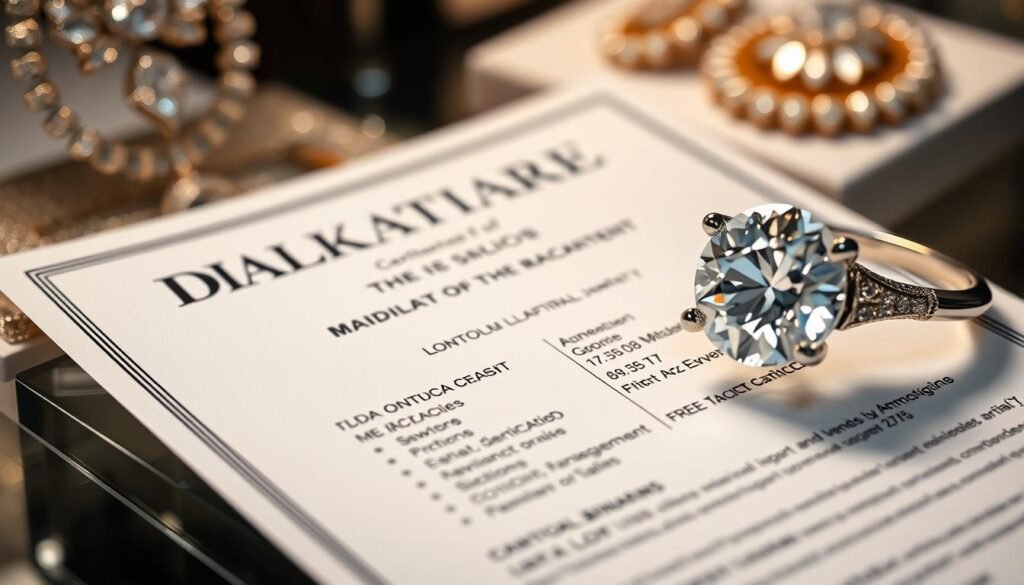
Choosing a certified diamond is smart. It means you’re sure about the quality and value. Understanding diamond certification and reports helps you buy with confidence.
Ethical Diamond Sourcing and Sustainability
We often look for ways to match our values with our purchases. Diamonds are no exception. Ethical diamond sourcing means diamonds are mined responsibly. This ensures they are conflict-free and mined with care for the environment and local people.
The diamond world has faced criticism over “conflict diamonds.” These are mined in war zones and fund violence. The Kimberley Process was created to stop this. It certifies diamonds as conflict-free, so you know yours is safe.
- Responsible mining practices: Ensuring fair labor conditions, environmental preservation, and community engagement.
- Conflict-free diamonds: Diamonds that are certified to be sourced from regions free from armed conflict.
- Kimberley Process: A global certification scheme that verifies the origin of diamonds to eliminate the trade of conflict diamonds.
Sustainability is also key in the diamond world. Big diamond producers are working to lessen their environmental footprint. They use green energy, save water, and protect wildlife.
“As the diamond industry continues to evolve, ethical and sustainable practices are becoming increasingly important to conscientious consumers.”
Choosing diamonds that are ethically sourced and certified helps the industry grow responsibly. This way, your purchase supports a better future for diamonds.

Current Engagement Ring Trends and Timeless Styles
Engagement rings are always changing, but some styles stay the same. You might love the old-world charm of antique designs or the modern look of minimalist rings. There’s something for everyone, from the latest diamond trends to custom rings that show off your love in a unique way.
The solitaire diamond ring is a classic choice. It’s loved for its simple yet elegant design. You can find it in many styles, like pavé bands and halo settings, which make the diamond sparkle even more. For a modern look, sleek rings with clean lines and shapes are popular.
Vintage-inspired rings are also in style. They have detailed designs and a nostalgic feel. These rings can have intricate filigree, clusters of stones, or unique diamond shapes. They offer a romantic and classic appeal that many couples love.

Hi, I’m Jimmy, the founder of Brilliant Jewelry Guide. With years of experience and a passion for timeless jewelry, I’m here to help you find pieces that tell your story and celebrate life’s special moments.
Disclaimer: This article contains affiliate links, which means we may earn a small commission if you purchase through them, without any additional cost to you. The content on this website was developed with assistance from AI.
